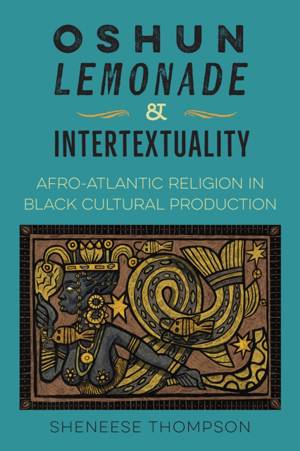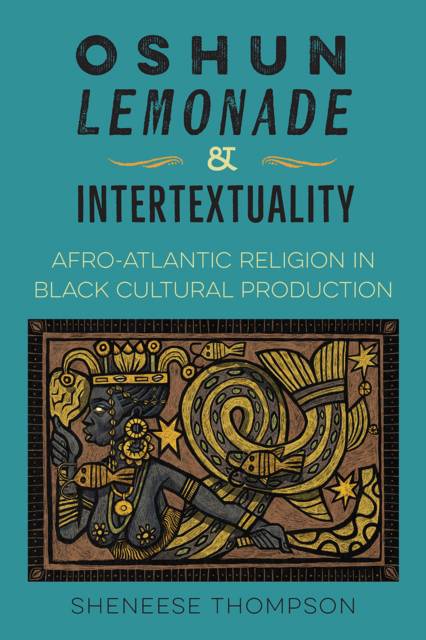
- Retrait gratuit dans votre magasin Club
- 7.000.000 titres dans notre catalogue
- Payer en toute sécurité
- Toujours un magasin près de chez vous
- Retrait gratuit dans votre magasin Club
- 7.000.0000 titres dans notre catalogue
- Payer en toute sécurité
- Toujours un magasin près de chez vous
Oshun, Lemonade, and Intertextuality
Afro-Atlantic Religion in Black Cultural Production
Sheneese Thompson
Livre broché | Anglais
31,45 €
+ 62 points
Format
Description
Exploring how Afro-Atlantic religion has been used to
portray Black womanhood by writers and artists from Beyoncé to Ntozake Shange
In this book, Sheneese
Thompson analyzes works of film and literature to explore how Afro-Atlantic
religion intersects with themes of resilience in Black femininity and
womanhood. Focusing on Beyoncé's visual album Lemonade, Thompson
examines iconography of the Yoruba goddess Oshun, represented by rivers, the
color yellow, and other symbols. Thompson argues that Beyoncé's tribute to
Oshun creates a narrative of self-repossession amid external definitions,
generational trauma, and emotional violence and draws connections to other works
that feature similar religious references. Oshun, "Lemonade," and Intertextuality also explores
Beyoncé's album Black Is King, the television series She's Gotta Have
It, Julie Dash's movie Daughters of the Dust, Ntozake Shange's novel
Sassafrass, Cypress & Indigo, and Jamaica Kincaid's stories
in At the Bottom of the River. These works highlight the significance of
African traditional religions for the healing and transformation of their characters.
Thompson discusses the ways in which Yoruba and Lucumí imagery and practices
such as oríkì, or praise poetry, have long been incorporated into Black
cultural texts such as these to tell stories of racial and gender-based
injustices. In looking at Lemonade together with influential older texts
created by Black women, Thompson establishes the use of Afro-Atlantic
religion--to think through Black womanhood, to explore self-defined sexuality--as
a central tenet of Black women's literature, one that these artists and writers
have brought to the global stage. Publication of
this work made possible by a Sustaining the Humanities through the American
Rescue Plan grant from the National Endowment for the Humanities.
portray Black womanhood by writers and artists from Beyoncé to Ntozake Shange
In this book, Sheneese
Thompson analyzes works of film and literature to explore how Afro-Atlantic
religion intersects with themes of resilience in Black femininity and
womanhood. Focusing on Beyoncé's visual album Lemonade, Thompson
examines iconography of the Yoruba goddess Oshun, represented by rivers, the
color yellow, and other symbols. Thompson argues that Beyoncé's tribute to
Oshun creates a narrative of self-repossession amid external definitions,
generational trauma, and emotional violence and draws connections to other works
that feature similar religious references. Oshun, "Lemonade," and Intertextuality also explores
Beyoncé's album Black Is King, the television series She's Gotta Have
It, Julie Dash's movie Daughters of the Dust, Ntozake Shange's novel
Sassafrass, Cypress & Indigo, and Jamaica Kincaid's stories
in At the Bottom of the River. These works highlight the significance of
African traditional religions for the healing and transformation of their characters.
Thompson discusses the ways in which Yoruba and Lucumí imagery and practices
such as oríkì, or praise poetry, have long been incorporated into Black
cultural texts such as these to tell stories of racial and gender-based
injustices. In looking at Lemonade together with influential older texts
created by Black women, Thompson establishes the use of Afro-Atlantic
religion--to think through Black womanhood, to explore self-defined sexuality--as
a central tenet of Black women's literature, one that these artists and writers
have brought to the global stage. Publication of
this work made possible by a Sustaining the Humanities through the American
Rescue Plan grant from the National Endowment for the Humanities.
Spécifications
Parties prenantes
- Auteur(s) :
- Editeur:
Contenu
- Nombre de pages :
- 174
- Langue:
- Anglais
Caractéristiques
- EAN:
- 9780813081106
- Date de parution :
- 15-07-25
- Format:
- Livre broché
- Format numérique:
- Trade paperback (VS)
- Dimensions :
- 152 mm x 229 mm
- Poids :
- 244 g

Les avis
Nous publions uniquement les avis qui respectent les conditions requises. Consultez nos conditions pour les avis.






